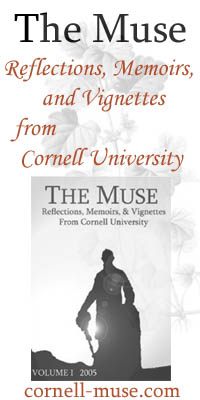In wake of Columbia's announcement that it will follow Harvard, Yale, Stanford, UPenn, and Princeton to cover the full cost of tuition to all incoming students with a family income of less than $50,000 dollars a year, how is Cornell fairing in offering grants to students with need-based aid? A recent, wonderfully written, Cornell Alumni Magazine article helps to paint the picture for us:At Cornell... only 30 to 35 percent of students pay full tuition (almost $33,000 a year in the endowed colleges). Almost half of the undergraduates receive need-based aid, with a combined value close to $110 million annually in loans and grants. Yet the University typically requires students receiving aid to supply $11,500 from work and loans during each academic year, the highest self-support requirement in the Ivy League. Matching Penn's grant policy for one year would raise Cornell's aid outlay by $12 million; matching Harvard would cost more than $17 million.
$17 million doesn't seem like a whole lot, but the University's endowment would have to increase by $350 million in order to cover those expenses on a yearly basis.
Even so, the University is able to enroll a lot more students from lower-income backgrounds than its peers:
At Princeton, where all students receiving aid get grants, not loans, only about 17 percent have family incomes lower than $60,000. At Cornell, close to 25 percent fall into that category...But in a perverse outcome, this just makes it more costly to provide aid for such students. Princeton only has 700 such students it needs to cover. Cornell? Five time as many: 3500.
And Cornell actually over-enrolled students last year because it anticipated that it would be a less attractive destination to students than what it was:
Unable to beat the competition and concerned that more students than usual might decline offers from Cornell in favor of better financial aid elsewhere, the University's admissions office increased the number of acceptance letters it mailed this year. Those fears proved unfounded, though, and the Class of 2010 overenrolled by almost 200 students. "My guess, from the way things turned out, is that our packages were just as appealing as what our applicants were getting from other schools," says Doris Davis, associate provost for admissions and enrollment. "Or, setting financial aid aside, it's the total package Cornell presents. For those students making decisions about where to enroll, it doesn't always come down to finances."Still, the article correctly establishes that unless Cornell is able to increase its financial aid coffers, its long-standing tradition of enrolling students from working and middle-class backgrounds may be in jeopardy. This, no doubt, will be a main thrust of the University's upcoming capital campaign, and I hope all alums will be at least able to give a nominal sum to outstanding programs like the Cornell Tradition.
But with the Alumni Magazine's great coverage on the need for Cornell to have more financial aid available to its students, it kinds of begs the question: Why doesn't the University send the magazine to all of its alumni?


